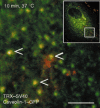Mechanisms of viral entry: sneaking in the front door
- PMID: 20446005
- PMCID: PMC3038234
- DOI: 10.1007/s00709-010-0152-6
Mechanisms of viral entry: sneaking in the front door
Abstract
Recent developments in methods to study virus internalisation are providing clearer insights into mechanisms used by viruses to enter host cells. The use of dominant negative constructs, specific inhibitory drugs and RNAi to selectively prevent entry through particular pathways has provided evidence for the clathrin-mediated entry of hepatitis C virus (HCV) as well as the caveolar entry of Simian Virus 40. Moreover, the ability to image and track fluorescent-labelled virus particles in real-time has begun to challenge the classical plasma membrane entry mechanisms described for poliovirus and human immunodeficiency virus. This review will cover both well-documented entry mechanisms as well as more recent discoveries in the entry pathways of enveloped and non-enveloped viruses. This will include viruses which enter the cytosol directly at the plasma membrane and those which enter via endocytosis and traversal of internal membrane barrier(s). Recent developments in imaging and inhibition of entry pathways have provided insights into the ill-defined entry mechanism of HCV, bringing it to the forefront of viral entry research. Finally, as high-affinity receptors often define viral internalisation pathways, and tropism in vivo, host membrane proteins to which viral particles specifically bind will be discussed throughout.
Figures




References
Publication types
MeSH terms
Substances
Grants and funding
LinkOut - more resources
Full Text Sources
Other Literature Sources

